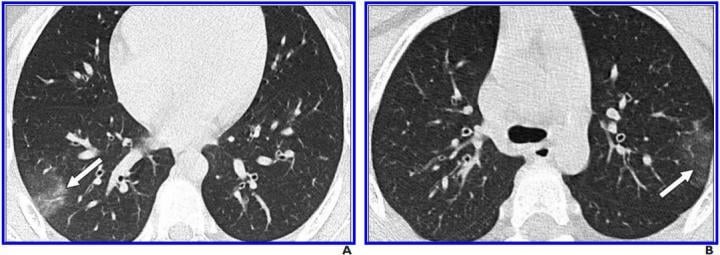
A and B, Unenhanced chest CT scans show minimal GGOs (right lower and left upper lobes) (arrows) and no consolidation. Only two lobes were affected, and CT findings were assigned CT severity score of 2. Image courtesy of American Journal of Roentgenology (AJR)
May 29, 2020 — An investigation published open-access in the American Journal of Roentgenology (AJR) revealed a high frequency of negative chest computed tomography (CT) findings among pediatric patients with laboratory-confirmed coronavirus disease (COVID-19), while also suggesting that bilateral, lower lobe-predominant ground-glass opacities (GGOs) are common in the subset of patients with positive CT findings.
"To our knowledge," wrote first author Sharon Steinberger from the Icahn School of Medicine at Mount Sinai, "this case series is the largest series to date that describes the imaging findings of pediatric patients with COVID-19."
Reviewing the CT findings and clinical symptoms of 30 pediatric patients (aged 10 months to 18 years) who tested positive for COVID-19 via quantitative real-time reverse transcription-polymerase chain reaction (rRT-PCR) at six centers in China from January 23 to February 8, 2020, Steinberger and colleagues noted that two cardiothoracic radiologists and a cardiothoracic imaging fellow characterized and scored the extent of lung involvement.
"CT findings were often negative (77%)," Steinberger et al. concluded, adding that positive CT findings seen in children included GGOs with peripheral lung distribution, crazy paving pattern, as well as the halo and reverse halo signs.
Consistent with reported symptomatology in children, the authors of this AJR article also observed a correlation between increasing age and increasing severity of findings.
Further questioning the utility of CT in the diagnosis and management of COVID-19 in children, 11 of 30 patients (37%) underwent follow-up chest CT--with 10 of 11 examinations (91%) showing no change.
For more information: www.
Related Coronavirus Content:
New Study Looks at Post-COVID-19 Emerging Disease in Children
VIDEO: Imaging COVID-19 With Point-of-Care Ultrasound (POCUS)
The Cardiac Implications of Novel Coronavirus
CT Provides Best Diagnosis for Novel Coronavirus (COVID-19)
Radiology Lessons for Coronavirus From the SARS and MERS Epidemics
Deployment of Health IT in China’s Fight Against the COVID-19 Epidemic
Emerging Technologies Proving Value in Chinese Coronavirus Fight
Radiologists Describe Coronavirus CT Imaging Features
Coronavirus Update from the FDA
CT Imaging of the 2019 Novel Coronavirus (2019-nCoV) Pneumonia
CT Imaging Features of 2019 Novel Coronavirus (2019-nCoV)
Chest CT Findings of Patients Infected With Novel Coronavirus 2019-nCoV Pneumonia
Find more related clinical content Coronavirus (COVID-19)
ACC COVID-19 recommendations for the cardiovascular care team
VIDEO: What Cardiologists Need to Know about COVID-19 — Interview with Thomas Maddox, M.D.
The Cardiac Implications of Novel Coronavirus
ESC Council on Hypertension Says ACE-I and ARBs Do Not Increase COVID-19 Mortality


 December 17, 2025
December 17, 2025 









